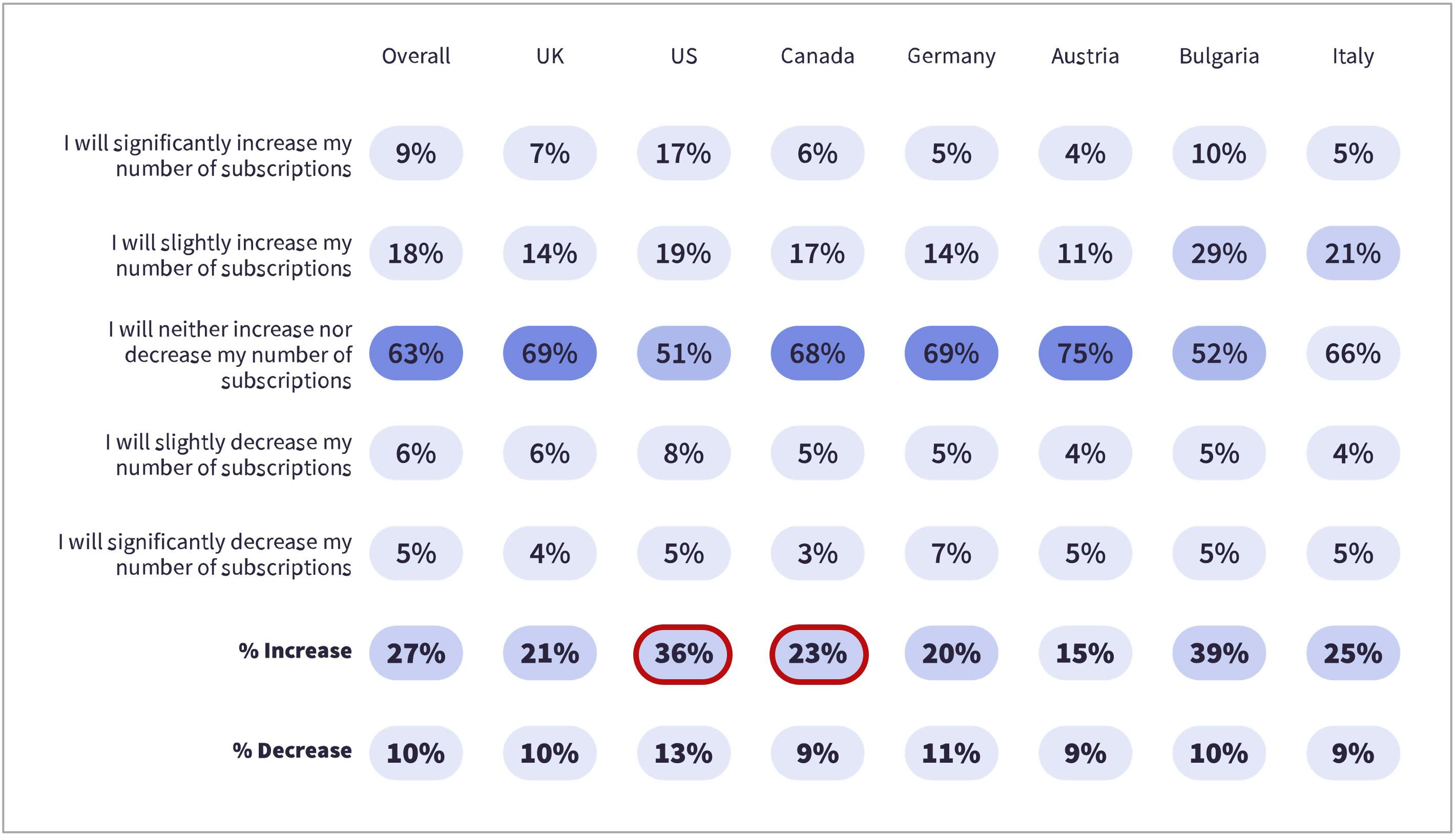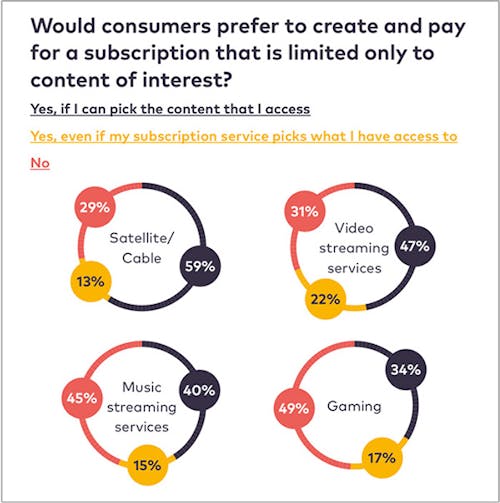Blog
March 31, 2021 | Authored by: Vindicia Team
Six common subscription myths and the strategies that prove them wrong
The pandemic gave the subscription market a major boost, drawing more interest to companies with less traditional business models. With people spending more nights and weekends in the comfort of their own homes and looking out for novel experiences, the rise of unconventional products and business models comes as no surprise. In fact, according to Paysafe Insights, 69% of Americans admit to using multiple subscription services, with 28% having at least four to date.
Yet with this adoption rate, which is only expected to increase, comes undeniable intimidation for businesses looking to “get their feet wet” in the world of subscriptions. So why would businesses considering an expansion into subscription services be hesitant to make the move? Much like every other major business model, there are several prevailing myths about this industry that may have business owners second-guessing this business model and strategic direction.
By addressing common myths, businesses can feel more confident about their decision to get into subscription services. Here are some of the most common misconceptions surrounding subscriptions, debunked:
Myth 1: Customers prefer owning over subscribing
Customer preferences will vary on a case-by-case basis. While some desire full to some form of ownership through licenses and entitlements, others prefer having the freedom to obtain products and services as they go via the subscription business model. Companies like Adobe and Microsoft previously sold software that delegated full ownership rights to buyers (remember those CDs from the early 2000s?). This was the traditional way to pay, own, and use that many preferred. Over time, these companies found that updates and new installments were a pain to implement on fully owned software, which pushed users to have no choice but to buy the next version of the software with updates. Today, Adobe, Microsoft, and other software-based companies have fully switched to subscription models for monetizing their products to consumers who want more ways to utilize everything a suite of products has to offer. Since the switch, Adobe’s subscription has proven indispensable in its ability to enable software subscribers to get access to the most updated software with new features, bug fixes, and innovative updates that can be implemented over the air.
Furthermore, trends show that consumers do prefer being able to subscribe and cancel anytime, getting access to the most updated, compatible, and valuable products without having to shell out money for ownership of entire products. In a sense, subscriptions help consumers control the way they want to spend their money and use products and services. A subscription model comes with the flexibility to pay for use on a prorated basis and opt-out in the same way – especially useful for digital media, software, and publishing companies that constantly dole out updates and improvements. In fact, Microsoft launched Office 365 subscription, pitching the subscription against the one-time purchase Office 2019 license. Office 2019 is the last license-based version that consumers can keep forever, but Microsoft makes it abundantly clear that Office 2019 is lacking essential AI-driven tools. On top of that, updates are capped and need to be done manually. For the benefit of your user experience? Choose Office 365 subscription for long-term compatibility with your goals. These industry trends have us convinced that more consumers prefer subscriptions to full ownership of digital products and software licenses. Although there’s a steady mix of preferences across other industries, there are far more upsides than downsides to partial ownership and consumption choices that subscriptions offer.
Myth 2: Subscription packages have many unique nuances that can be difficult to manage for both merchants and subscribers
Transitioning to a subscription service may feel a little overwhelming in the beginning as merchants find the most effective ways to categorize, present, and price offerings. Subscriptions have their own set of rules, pricing, and presentation that can be vague for companies who are starting to consider implementing the model as their primary monetization model. Unlike licenses and products giving full ownership, the subscription is complicated for its many nuances. These same nuances have more pros than cons, and a key one is that companies can forge recurring relationships and transactions with customers. Essentially, customers are never “won and done.”
Take pricing, for example, there are on average over two dozen ways to create various tiers and structures that best present offerings and values to customers. However, the variety may create confusion in the billing and transactions department. Instead of worrying that your subscription packages and offerings will be too complex to manage billing requirements and other nuances that inevitably come up, find ways to make the subscription experience a smooth and seamless one by reflecting on how consumers can best derive value from the way the subscription package is designed and set up. Plan out the packages you will offer and make them flexible for customers, create a solid pricing structure, figure out how to manage the subscription cycle, and decide what type of metrics you will track to ensure this move was made with good intentions for the life and longevity of your business. Subscriptions are some of the simplest offerings to launch and manage. Don’t let the supposed complexities around pricing and presenting offerings scare you.
Myth 3: Subscriptions are a passing fad
The future of the subscription service industry is looking bright. Data from Paysafe Insights shows that 36% percent of U.S. customers who currently subscribe to something want to subscribe to more subscriptions in the future. In Canada, 23% want to increase their number of subscriptions. The North American subscription economy is looking opportunistic.

Additionally, only 10% of all survey respondents around the globe admitted that they were likely to decrease the number of subscriptions they have. These insights can shine a light on the idea of using a subscription model for businesses that might currently be on the fence.
Myth 4: Customers are going to churn whether you use subscription models or not
Business owners may always have the thought of customer churn in the back of their minds, but that shouldn’t be reason enough to dismiss the idea of starting subscription services altogether. Instead of going into this new business model with the idea that customers will leave just because you started offering subscription services, make it a point to pay close attention to metrics that reveal consumer behaviors during the initial transitional stages. Understanding your customer engagement rates will give you a better idea of what your customers are expecting and can help you improve your business model types all around.
“If I’m interested in keeping customers, I’m interested in understanding how many leave and the underlying reasons why they are ending their relationship with me,” Jill Avery, a senior lecturer at Harvard Business School shared with the publication. “Looking at churn rates by customer segment illuminates which types of customers are at risk and which may require an intervention. It’s a nice simple metric that tells us a lot about when and how to interact with customers.” In fact, the nature of subscriptions is one of the most effective for preventing and lowering churn thanks to its knacks for creating renewable, personalized experiences for customers that automatically continue without customers needing to lift a finger. Trust and relationship-building are built into the subscription business model.
Myth 5: Retention is not as important as an acquisition for growth
While retaining existing subscribers yields greater recurring revenue, subscription renewals and sign-ups – by default – are not guaranteed. The same goes for anything in life and business. In fact, another common thought is that subscribers typically churn come renewal time. Retaining and getting users to stay subscribed is a form of re-acquiring. Effective acquisition and retention efforts are related. For one, subscription merchants should always be catering to customers’ needs. Personalizing offerings and renewal opportunities should be your top priority, and it’s proven effective for reminding potential and existing users of the value they can reap from your subscription. Lastly, turn to data. Data discloses the myriad of ways that your users are interacting with your subscription, and by using data, a merchant can tailor bids and products to deliver on users’ specific wants, needs, and expectations. Subscription intelligence is designed to answer these questions and provide applicable recommendations for lowering churn.

For example, parent company Amdocs Media recently gathered some interesting insights from a survey of consumer choices relevant to content and streaming subscriptions. The results reveal that most content subscribers want the ability to choose the content they want access to. This rang true across satellite/cable, music streaming, video streaming, and gaming subscriptions. Subscription merchants should always present subscribers with not only value and content that’s relevant, but also make easy access and variety two cornerstones of subscriptions. Product variety helps acquire more customers by appealing to diverse segments of the population while making the product accessible helps customers use what they’re paying for. These strategies are proven to help subscription-based businesses consistently attract, acquire, and retain customers – all equally important.
Myth 6: Getting started with a subscription model is too hard and the returns are not guaranteed
The subscription model is a worthy consideration for businesses that want to diversify offerings, expand consumer base, and increase the ROI of acquisition dollars. The business model’s versatility in growing recurring revenue and ability to forge direct relationships with customers enables businesses to smartly and quickly bring products and services to the market. These qualities are especially useful for direct-to-consumer businesses looking to grow loyal followers and deliver a product in a different or more consumable way.
In turn, the Vindicia MarketONE cloud-based, SaaS platform provides all the ingredients essential for bringing these qualities into action. The ingredients include an acquisition portal, a retention engine, and subscription intelligence that work together to help subscription-based businesses determine the unique strategies they need to implement in order to thrive in their respective subscription industry. If you’re a B2C business interested in offering a subscription service or want to grow various revenue streams, Vindicia MarketONE is the go-to that executes the full range of strategies surrounding launching and scaling businesses.
Learn more about what our solutions can do for your growth metrics by contacting us directly today.
About Author

Vindicia Team
We value our subject matter experts and the insights each of them brings to the table. We want to encourage more thought leaders to come together and share their industry knowledge through our blog. Think you have something interesting to contribute as a guest blogger? Contact us at info@vindicia.com